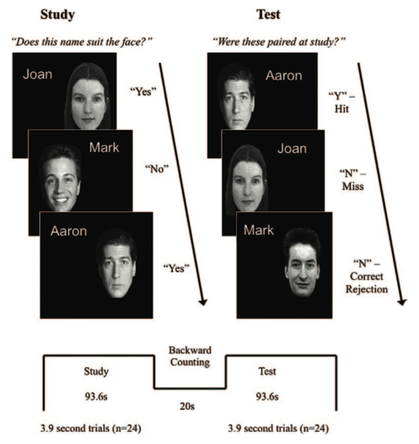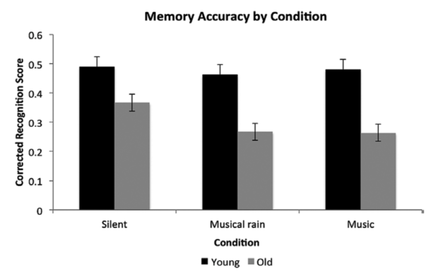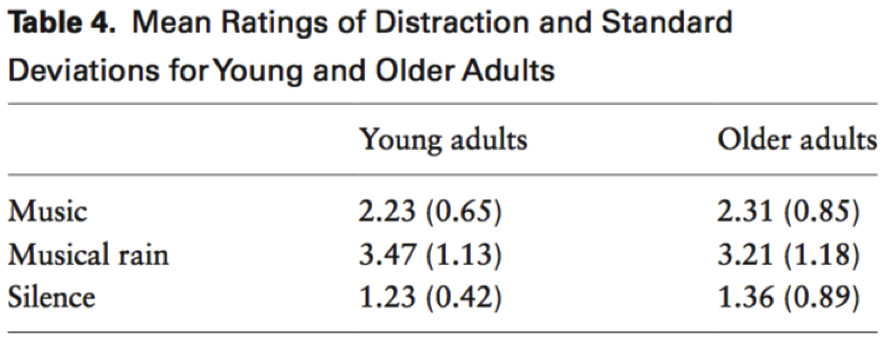Turn Off the Music! Music Impairs Visual Associative Memory Performance in Older Adults
This study investigates the impact of background music on a paired associate learning task in healthy young and older adults.
Click here to read the full paper.
Click here to read the full paper.
Two key theories explain why music may aid memory:
Arousal Mood Hypothesis - Background music may affect memory by altering the listener’s mood (i.e.; happy or sad) and arousal states (i.e.; high or low intensity). This theory postulates that optimal memory performance occurs when you are in a happy mood with not too little or too much arousal.
The Encoding Specificity Principle – Background music may affect memory if the same music presented during studying is reinstated during test. This theory postulates that optimal performance occurs when the conditions are similar at study and test.
Arousal Mood Hypothesis - Background music may affect memory by altering the listener’s mood (i.e.; happy or sad) and arousal states (i.e.; high or low intensity). This theory postulates that optimal memory performance occurs when you are in a happy mood with not too little or too much arousal.
The Encoding Specificity Principle – Background music may affect memory if the same music presented during studying is reinstated during test. This theory postulates that optimal performance occurs when the conditions are similar at study and test.
The Participants
Total of 117 participants
57 young adults (aged 18-30 years)
60 older adults (aged 60-75 years)
57 young adults (aged 18-30 years)
60 older adults (aged 60-75 years)
The Stimuli
Music was chosen to be high in valence (positive mood) and vary in arousal (high, low).
Different song lists were used for the younger and older adults, to ensure that both group listened to high valence music, based on ratings from their age groups. Six songs were chosen for each stimuli condition, below is an example of each.
Younger Adults
High arousal positive – Cliffs of Dover
Low arousal positive – O Leaozinho
Older Adults
High arousal positive – Hello My Lovely
Low arousal positive – Prelude in E Minor
Context was also manipulated to see if background music is most beneficial when the same song is played during testing as was played during studying. The Musical Rain and Silence conditions were control conditions to see if music overall aids or impairs memory performance.
Types of Conditions:
Study & Test - High Arousal Music
Study & Test - Low Arousal Music
Study & Test - Same Song
Study & Test - Different Song
Study & Test - Musical Rain
Study & Test - Silence
Different song lists were used for the younger and older adults, to ensure that both group listened to high valence music, based on ratings from their age groups. Six songs were chosen for each stimuli condition, below is an example of each.
Younger Adults
High arousal positive – Cliffs of Dover
Low arousal positive – O Leaozinho
Older Adults
High arousal positive – Hello My Lovely
Low arousal positive – Prelude in E Minor
Context was also manipulated to see if background music is most beneficial when the same song is played during testing as was played during studying. The Musical Rain and Silence conditions were control conditions to see if music overall aids or impairs memory performance.
Types of Conditions:
Study & Test - High Arousal Music
Study & Test - Low Arousal Music
Study & Test - Same Song
Study & Test - Different Song
Study & Test - Musical Rain
Study & Test - Silence
The Tasks

There were two blocks for each of the six conditions, each block consisted of a study phase and a test phase. The order of the blocks was randomized across participants. During the study phase, participants studied 24 face-name pairs for 3.9 seconds each and responded based on whether they thought the name suited the face. During the test phase, participants viewed 24 face-names pairs and determined whether the same pairs were previously presented together.
After each block, participants were asked to rate how distracting they found the music to their ability to perform the task.
After each block, participants were asked to rate how distracting they found the music to their ability to perform the task.
The Results

Neither the arousal manipulations (high, low) nor the context manipulations (same song, different song) produced any notable results. For this reason data was collapsed across conditions (silent, musical rain, music).
Comparisons across conditions revealed that there were no differences in memory accuracy between any of the conditions and silence for the young adults.
For older adults, all conditions except the low arousal and different song condition were significantly impaired to silence.
Comparisons across conditions revealed that there were no differences in memory accuracy between any of the conditions and silence for the young adults.
For older adults, all conditions except the low arousal and different song condition were significantly impaired to silence.
Conclusion
Associative memory accuracy was unaffected by the presence of music in young adults but impaired when any music was played for the older adults. Rather than being supportive of ongoing memory performance, background music is at best distracting for young adults and at worst distracting and detrimental to performance for older adults. Results of the present study are most consistent with the theory that older adults’ failure to inhibit processing of distracting task-irrelevant information, in this case background music, contributes to their memory impairments.
